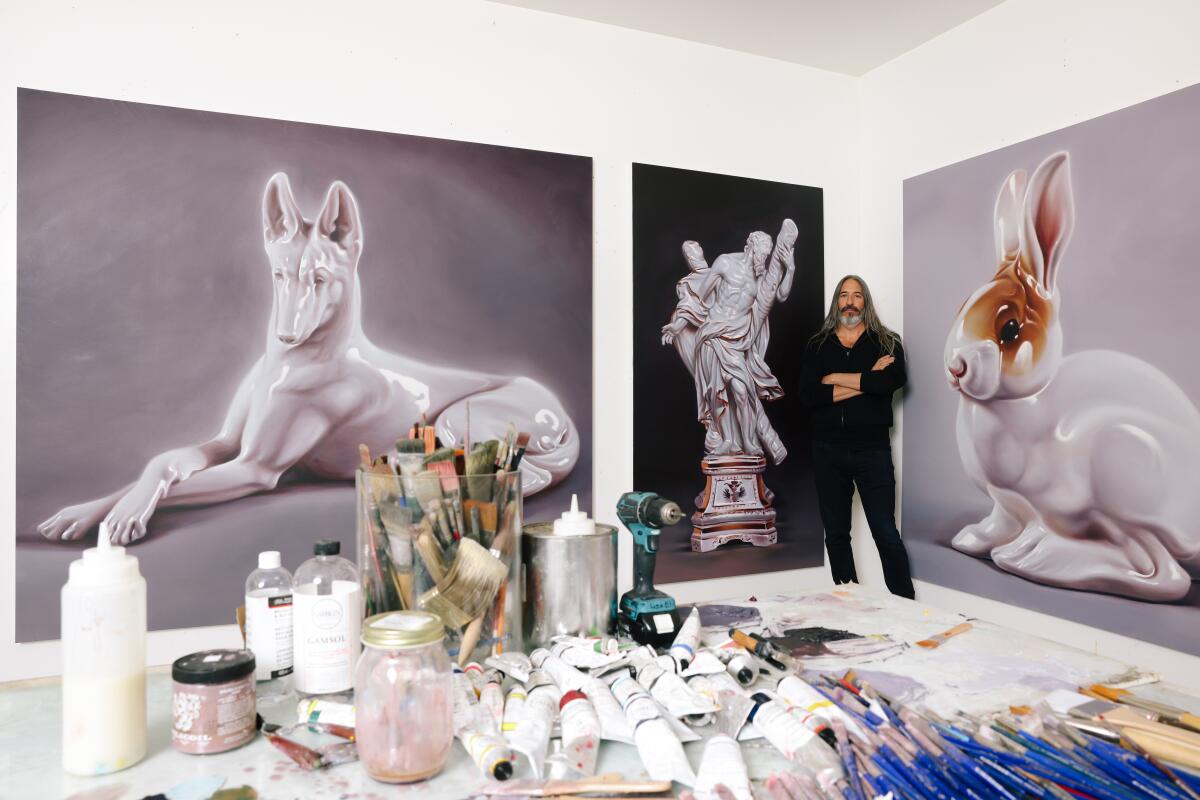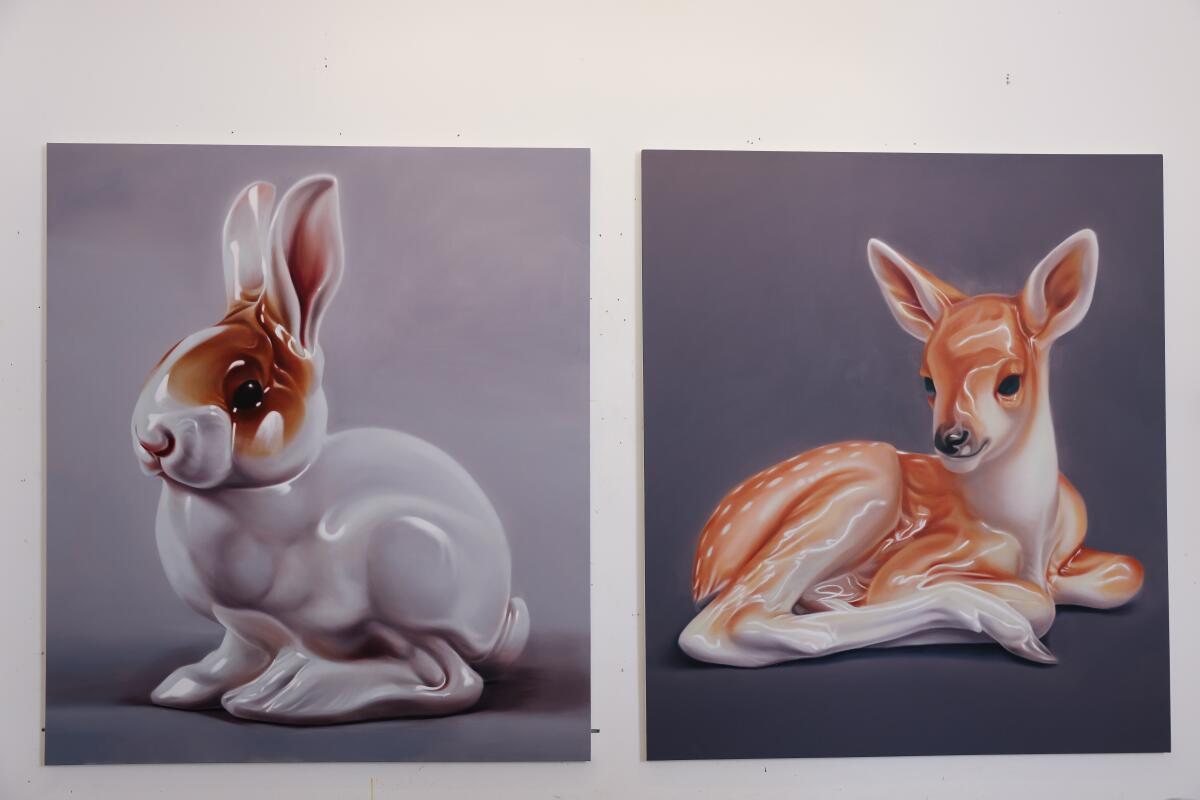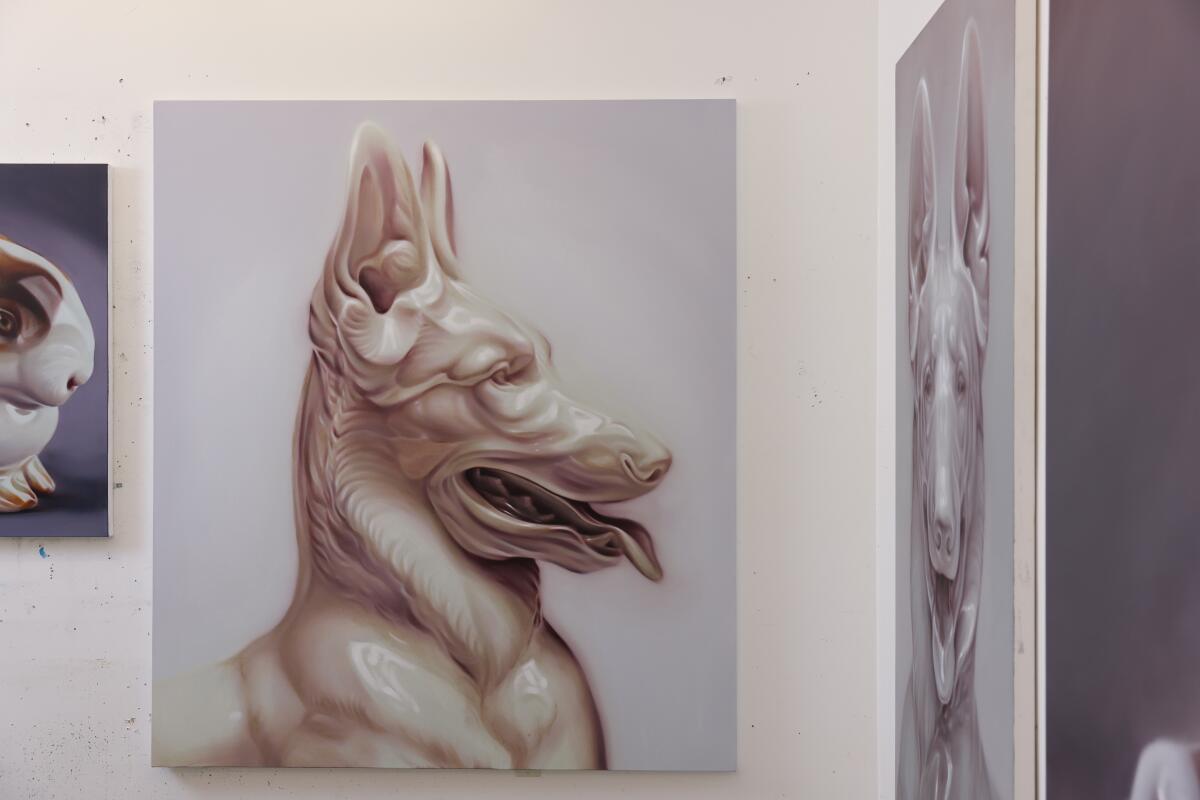Robert Russell’s paintings illuminate the dark history of the slave laborers of Dachau

- Share via
We know this about former Nazi Party leader Heinrich Himmler: He was a mass murderer. He was a key player in orchestrating the Holocaust — true evil, personified.
Lesser known: Himmler was into bunnies. And puppies. And baby lambs. Specifically: cutesy, porcelain tchotchkes of such creatures.
A new solo exhibition of work by painter Robert Russell, at Anat Ebgi gallery in Carthay, shines a light on the dark history of these innocent objects.
“Porzellan Manufaktur Allach” features about a dozen of Russell’s enormous paintings — rich, detailed still lifes of porcelain figurines produced in Germany, in the 1930s and ’40s, through the Allach Porcelain Manufacturing Co.
Himmler, through the SS, took over the company in the mid-1930s and used it to produce, among other things, porcelain statuettes that conveyed his love of Aryanism and Germanic culture — a pure white dove, a wide-eyed doe. The Nazis gifted SS soldiers with the objects — “marriage gifts, baby gifts, for moving up the ranks,” says Russell, who is Jewish.
When, eventually, there were labor shortages during the war, Himmler opened an Allach production facility in a subcamp outside of the Dachau concentration camp in Germany and used the prisoners there as slave labor to keep production going.
“It’s sort of a perfect subject for me to paint because there’s a vulnerability to it, which I like, but there’s something horrific about it,” Russell says. “Also, there’s something kind of medicinal about it. I want to make something ugly beautiful. I want to sort of take it back, give it new meaning. I just want to make big, beautiful paintings out of this stuff.”

Hanging in Russell’s home studio about a week before the exhibition, the 7-foot-tall paintings are both hauntingly pretty and grotesque, given the history and their enormity. At first glance they highlight seemingly benign objects one might find in their grandmother’s den — creamy white and golden brown statues of innocent-looking forest animals, a Roman saint figurine with touches of gold leaf. The hyper-realistic renderings are glossy-looking and luminescent, glinting with light and shadows — as if slathered with donut glaze. The largely monochromatic objects are pictured against different hues of lavender, from near-black purple to pale lilac.
Together in Russell’s one-room studio, however, they appear almost threatening — a gang of super-sized cuteness looming over visitors. Russell’s studio is small and stark, with no windows — just four, white walls closing in around a 6-foot-long, glass-covered dining table, smack in the center of the room, that he uses as a giant, paint-smeared palette. The canvases encircle the room and are so big, there’s little visible wall space. The works feel perverse, but also defiantly seductive.
“I wanted to kind of acknowledge the monstrousness of that whole endeavor,” Russell says of the porcelain figurines. “To take them out of the realm of cutesy. These could have been done very precious — I could have made little paintings. And they would have only stayed precious. Here they’re so assertive. You have to deal with it.”
“Porzellan Manufaktur Allach” is especially relevant right now. Since 2014, antisemitism has been on “a meteoric rise in the U.S.,” says USC Shoah Foundation Executive Director Robert J. Williams. In L.A. alone, several weeks ago, two men were shot in separate incidents leaving synagogues in the Pico-Robertson neighborhood. The suspect, who had a history of making antisemitic remarks, was charged with federal hate crimes.
“The ongoing prevalence of antisemitism, that is absolutely a feature of this body of work,” Russell says.

Russell, 51, grew up Reform Jewish in L.A. He was relatively disconnected from his heritage for most of his adult life but reembraced Judaism — “a version of it that feels more meaningful to me” — about a decade ago, diving into books, attending community events and holding shabbat dinners at home with his wife, the actress Lisa Edelstein. “Not to sound cliché, but it’s brought meaning,” he says.
The two live in the Edward A. “Tink” Adams House in Silver Lake — Los Angeles Historic-Cultural Monument No. 922 — which was was redesigned, in 1966, for the co-founder of ArtCenter College of Design. Edelstein is also a painter and she and Russell have studios on opposite ends of the property, which features Japanese-style gardens and hundreds-year-old bonsai trees. Their conversations about Jewish life, culture and spirituality have influenced both of their bodies of work, Russell says.
During the early days of the COVID-19 pandemic, Russell turned to painting teacups, giant detailed renderings of traditional, hand-painted, German porcelain. He later exhibited the series at Anat Ebgi in 2021. During that uncertain and terrifying pre-vaccine period, however, making those works — supersized domestic objects, with their oval-shaped openings and wide-brimmed saucers — opened up his world, he says, which had become “small” in isolation. At the same time, depicting intimate vessels for warm, fragrant liquid provided coziness and comfort.
“Porzellan Manufaktur Allach” grew directly out of the teacup series. It’s a continuation of Russell’s interest in painting porcelain objects, he says, but far more sculpturally complicated ones, considering the angles and curves of the animals’ bodies as opposed to a rounded cup. There’s also more room for Russell to assert a sense of self in the pieces. The teacup series depicted hand-painted objects featuring intricate floral patterns, so Russell’s works were “paintings about painting” he says, “because I was painting in another painter’s style.” By contrast, the far less decorative animal figures were more liberating, allowing him “to deal not only with surface, but form,” he says. “I’m staying true to the Allach pieces themselves, but there’s a lot of room for gesture and exploration.”
Although the works reference the medium of photography, Russell doesn’t refer to them as photorealistic. They’re painterly interpretations of photographic images. Russell finds the Allach porcelain images in online auction house catalogs. Before re-creating the pictures on canvas, he photoshops the images, saturating the colors and punching up the reflections and shadows.
“It gives them volume and depth and turns them into what I consider to be paint-worthy,” he says. “I think of them as almost psychedelic hyper-real — because I’m then making them massive.”
Russell also experimented with materials during the pandemic. He now mixes a pasty, cold wax in with his linseed oil and paint to create a unique concoction that gives the canvas surface a translucency that he sees as “parallel to the porcelain.”
The result is luminescence bathed in irony. A dachshund puppy with big, floppy ears is ensconced in a fuzzy, angelic haze; a baby lamb’s tufts of fur are so pearly white and light, like peaks of whipped cream, they’re almost sculptural-looking. Underneath, the real porcelain objects are stamped with the SS “runes” symbol.
Russell didn’t set out to create an exhibition with an agenda — education was not his first priority, he admits. As a conceptual painter interested in the Vanitas and Memento Mori styles of painting, he was drawn to the subject’s aesthetic simplicity and the complicated, fraught history.
“The content’s there, but I wanted to seduce you first,” he says.
Still, the works amplify an important historical narrative.
“This, ideally, will become part of the cultural milieu out there,” he says. “When you research Allach porcelain, you’ll hopefully discover this.”
'Robert Russell: Porzellan Manufaktur Allach'
Where: Anat Ebgi, 6150 Wilshire Blvd., Los Angeles
When: March 9 - April 22, Tues.-Sat., 10 a.m.-5 p.m.
Info: anatebgi.com
More to Read
The biggest entertainment stories
Get our big stories about Hollywood, film, television, music, arts, culture and more right in your inbox as soon as they publish.
You may occasionally receive promotional content from the Los Angeles Times.











